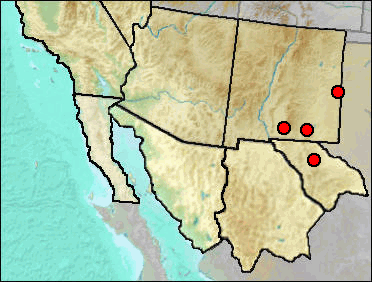Class Mammalia
Order Rodentia
Family Cricetidae
Subfamily Neotominae
Genus Peromyscus

Peromyscus leucopus is one of the more widespread mammals in North America. It generally is a rodent of mid and low elevations in our region. It occurs throughout the Trans-Pecos, New Mexico except the Four Corners, and eastern Arizona except the Four Corners region. It most often is found in the somewhat thicker vegetation of arroyos, although Cornely et al. (1981) found them in Guadalupe Mountains National Park most often on bajadas with desertscrub. However, they were not abundant within the park, and this seems to be the case also in other areas of the Trans-Pecos and of southern New Mexico.
Fossil records are rare. Only four specimens in the UTEP collection seem to be of this species; one of these (Bison Chamber, Dry Cave) is a specimen found on the surface moderately close to the cave entrance and thus may well be Holocene (Harris 1970a). Two specimens from Pendejo Cave are from Zone C, a stratum with mixed Holocene and late Pleistocene sediments. The fourth specimen is from Animal Fair (grid D7, level 8), Dry Cave; this portion of the Animal Fair site likely predates the late Wisconsin full glacial. It thus appears quite likely that this mouse was absent from southeastern New Mexico during much or all of Late Wisconsin time.
Sites.
Mid/Late Wisconsin: Animal Fair, Dry Cave (UTEP).
Late Wisconsin: Blackwater Loc. No. 1 (Morgan and Lucas 2005: ?).
Late Wisconsin/Holocene: Bison Chamber, Dry Cave (Harris 1970a); Fowlkes Cave (Dalquest and Stangl 1984b); Pendejo Cave, Zone C (UTEP: cf.).
Rejected. Late Wisconsin/Holocene: Balcony Room, Dry Cave (Harris 1993c); Beyond Bison Chamber, Dry Cave (Harris 1993c); Harris' Pocket, Dry Cave (Harris 1993c).
Literature. Cornely et al. 1981; Dalquest and Stangl 1984b; Harris 1970a, 1993c; Morgan and Lucas 2005.
Last Update: 9 Mar 2013